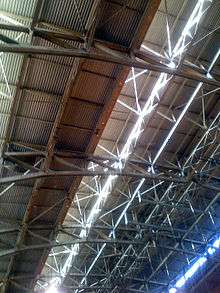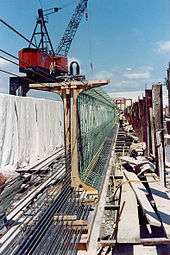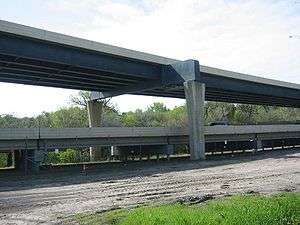Girder
A girder /ˈɡɜːrdər/ is a support beam used in construction.[1] It is the main horizontal support of a structure which supports smaller beams. Girders often have an I-beam cross section composed of two load-bearing flanges separated by a stabilizing web, but may also have a box shape, Z shape, or other forms. A girder is commonly used to build bridges.
| Look up girder in Wiktionary, the free dictionary. |

A girt is a vertically aligned girder placed to resist sheer loads.
Small steel girders are rolled into shape. Larger girders (1 m/3 feet deep or more) are made as plate girders, welded or bolted together from separate pieces of steel plate.[2]
The Warren type girder replaces the solid web with an open latticework truss between the flanges. This arrangement combines strength with economy of materials, minimizing weight and thereby reducing loads and expense. Patented in 1848 by its designers James Warren and Willoughby Theobald Monzani, its structure consists of longitudinal members joined only by angled cross-members, forming alternately inverted equilateral triangle-shaped spaces along its length, ensuring that no individual strut, beam, or tie is subject to bending or torsional straining forces, but only to tension or compression. It is an improvement over the Neville truss, which uses a spacing configuration of isosceles triangles.
Gallery
 Rebar being placed before casting a prestressed concrete girder
Rebar being placed before casting a prestressed concrete girder Bridge built using multiple I-girders
Bridge built using multiple I-girders.jpg) Bridge built using multiple box girders
Bridge built using multiple box girders A viaduct being built using U-girders
A viaduct being built using U-girders
See also
- Box girder
- Joist
- Plate girder
- Structural steel
- Truss
- Universal Beam
- Wide Flange Steel Materials and Rolling Processes (U.S.)
References
- Hirol, Isami (2008). Plate-Girder Construction. BiblioBazaar. ISBN 978-0-554-88802-6.
- Seshu, Adluri (17 Jun 2009). "Structural Steel Design: Plate Girders (class notes)" (PDF). Memorial University. Canada. Retrieved 2015-12-16.
- Song W, Ma Z, Vadivelu J, Burdette E (2014). Transfer Length and Splitting Force Calculation for Pretension Concrete Girders with High-Capacity Strands. Journal of Bridge Engineering. 19(7), DOI 04014026.
- Chen X, Wu S, Zhou J (2014). ”Compressive Strength of Concrete Cores with Different Lengths.” Journals Materials and Civil. Engineering, 26(7), DOI 04014027.